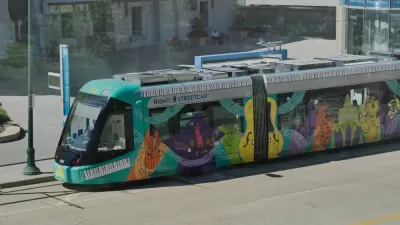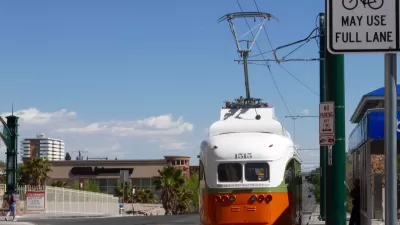An analysis of several streetcar systems shows that they bring different benefits based on a community’s goals.

A University of Kansas researcher says “Modern streetcar systems constructed since 2001 have achieved different outcomes depending on each city’s goals,” writes Dan Zukowski in Smart Cities Dive.
Some cities, such as Kansas City, use streetcars to fill gaps in transit systems and boost ridership by providing fare-free rides and connections to other local transit options. Others, like Atlanta and Cincinnati, built streetcar lines in underdeveloped areas as part of an effort to stimulate economic development and new construction there. Lori Burchett, deputy director for streetcar services with the city of Cincinnati, says that city’s streetcar led to a wave of new development in an area where 90 percent of properties were vacant in 2016.
Zukowski adds, “For streetcar systems to achieve success, Mendez recommended anchoring systems to existing activity centers and tapping into the existing base of transit ridership by making it easy for riders to connect with other transit options through tailored fare policies or infrastructure.”
FULL STORY: Streetcars’ benefits vary by city: panel

Planetizen Federal Action Tracker
A weekly monitor of how Trump’s orders and actions are impacting planners and planning in America.

Congressman Proposes Bill to Rename DC Metro “Trump Train”
The Make Autorail Great Again Act would withhold federal funding to the system until the Washington Metropolitan Area Transit Authority (WMATA), rebrands as the Washington Metropolitan Authority for Greater Access (WMAGA).

The Simple Legislative Tool Transforming Vacant Downtowns
In California, Michigan and Georgia, an easy win is bringing dollars — and delight — back to city centers.

The States Losing Rural Delivery Rooms at an Alarming Pace
In some states, as few as 9% of rural hospitals still deliver babies. As a result, rising pre-term births, no adequate pre-term care and harrowing close calls are a growing reality.

The Small South Asian Republic Going all in on EVs
Thanks to one simple policy change less than five years ago, 65% of new cars in this Himalayan country are now electric.

DC Backpedals on Bike Lane Protection, Swaps Barriers for Paint
Citing aesthetic concerns, the city is removing the concrete barriers and flexposts that once separated Arizona Avenue cyclists from motor vehicles.
Urban Design for Planners 1: Software Tools
This six-course series explores essential urban design concepts using open source software and equips planners with the tools they need to participate fully in the urban design process.
Planning for Universal Design
Learn the tools for implementing Universal Design in planning regulations.
Smith Gee Studio
City of Charlotte
City of Camden Redevelopment Agency
City of Astoria
Transportation Research & Education Center (TREC) at Portland State University
US High Speed Rail Association
City of Camden Redevelopment Agency
Municipality of Princeton (NJ)





























